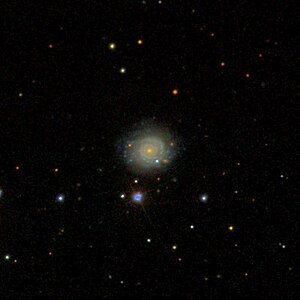NGC 226
| Galaxy NGC 226 |
|
|---|---|

|
|
| SDSS recording | |
| AladinLite | |
| Constellation | Andromeda |
|
Position equinox : J2000.0 , epoch : J2000.0 |
|
| Right ascension | 00 h 42 m 54.0 s |
| declination | + 32 ° 34 ′ 51 ″ |
| Appearance | |
| Morphological type | S? |
| Brightness (visual) | 13.4 mag |
| Brightness (B-band) | 14.4 mag |
| Angular expansion | 0.9 ′ × 0.6 ′ |
| Position angle | 105 ° |
| Surface brightness | 12.6 mag / arcmin² |
| Physical data | |
| Affiliation |
NGC 266 group NGC 315 group LGG 14 |
| Redshift | 0.016094 ± 0.000030 |
| Radial velocity | 4825 ± 9 km / s |
|
Stroke distance v rad / H 0 |
(223 ± 16) x 10 6 ly (68.3 ± 4.8) Mpc |
| history | |
| discovery | John Herschel |
| Discovery date | November 22, 1827 |
| Catalog names | |
| NGC 226 • UGC 459 • PGC 2572 • CGCG 500-076 • IRAS 00402 + 3218 • 2MASX J00425403 + 3234516 • GC 121 • h 53 • GALEX ASC J004254.05 + 323451.1 • LDCE 43 NED002 | |
NGC 226 is a galaxy of Hubble type S? in the constellation Andromeda in the northern sky . It is estimated to be 223 million light years from the Milky Way and about 60,000 light years in diameter .
The object was discovered on November 22, 1827 by the British astronomer John Herschel .
Web links
Commons : NGC 226 - collection of images, videos, and audio files
